Intelligent Well Completions
Intelligent well systems – Where we've been and where we’re going
Intelligent well applications have been proven in more than 130 wells. Available system status and what the next generation will be are reviewed, along with how managing IWs with real-time reservoir data will increase asset-value
Jack Angel, Baker Oil Tools
The upstream petroleum industry is in the relatively early stages of applying advanced intelligent well (IW) system technology. For operators who have made use of these systems, the potential of enhanced reservoir characterization and real-time production management has been realized with: reduction of workover and intervention costs, elimination of deferred production, acceleration of cash flow and incremental recoverables from producing assets.
With more than 130 intelligent wells – and over 220 remote flow-control devices installed to date IW systems are proving they can deliver on their promises. Equipment is reliable and payback is significant. And – perhaps most telling in an emerging market where performance and value are key drivers – most end users have become repeat buyers. IWS technology is quickly progressing beyond questions of whether it works and whether it can add value, to whether end-users’ infrastructures are capable of optimal application of the technology.
This article overviews IWS basics. It then discusses: history, drivers and enabling technologies; what next-generation systems will do; and managing data – the final hurdle.
IWS BASICS
The term intelligent (or smart) well generally refers to the migration downhole of fundamental process control. Today’s IW systems are real-time production and injection management networks that provide in-well monitoring, data assessment/modeling, and action in the form of remote flow control. IW systems acquire data parameters from advanced in-well sensors and allows the operator to change flow characteristics (production and/or injection) without need for well intervention. The closer measurements are made to the zone(s) of interest, the greater their resolution and ultimate value. Thus, in-well permanent sensors also contribute to a better understanding of specific production and/or injection zones, and near- and inter-well reservoir characteristics.
Intelligent well technology encompasses two primary instantaneous concepts: 1) real-time surveillance – the ability to acquire downhole flow and/or reservoir data; and 2) real-time control – the ability to remotely control flow by either on/off or variable choking.
Real-time data acquisition is possible with either conventional electronic or emerging photonic (fiber optic) instrumentation. The newest monitoring systems are transforming reservoir-specific sensors from temporary to permanent applications. Most of today’s commercially deployed systems include pressure, temperature and mass flowrate.
Options for real-time flow control range from hydraulic to electro-hydraulic to all-electric valves. Available settings of these control systems range from simple open/close, to multi-position, to infinitely variable.
HISTORY, DRIVERS AND ENABLING TECHNOLOGIES
The principal driving force behind IW technology is need to manage the complex technical, economic and environmental challenges that characterize many of today’s development scenarios. These challenges call into question many of the fundamental drivers and assumptions underlying conventional, intervention-based production management.
Most conventional well completion philosophies are derived from field development scenarios involving simple, vertical, land and/or platform-based wells, where this simplicity is viewed as the key to reliability. In such scenarios, a well will produce until the reservoir pressure declines, watercut increases, or some other problem downhole prevents the well from producing at its intended rate. Problems are generally diagnosed by analyzing surface pressure characteristics under various flowrate conditions. Additionally, a wireline production log may be run through the production tubing to take direct pressure/flow measurements at the sand face.
Drilling advancements from the 1980s and ´90s – specifically high-angle/horizontal, extended-reach and multilateral technologies – have resulted in fewer, more prolific wells. Additionally, reservoir settings and extreme environments, i.e., deep water, subsea, HPHT, commingled and floating production, etc., continually challenge conventional production management methods. By the mid-1990s, several important, co-existing conditions gave rise to both need and capability for remote monitoring and control of well completions. These included:
- More reliable subsea systems
- Significant deepwater discoveries
- Ever-increasing cost of deepwater wells
- More reliable downhole electronics and hydraulic systems, and
- Access to fiber-optic technology.
From these conditions emerged the key drivers of IW technologies, including:
- Fewer, larger well completions (in both tubulars and production rates)
- Pre-completion of primary, secondary and tertiary plays to exploit multiple reservoirs within the same primary wellbore
- Increased sensitivity to unplanned OPEX
- Greater reliability and availability requirements
- Need for early confirmation of reservoir models and depletion plans, and
- Need for high-quality, real-time downhole data, and multizone, remote, downhole production control to manage high-volume subsea completions.
The evolution of three oilfield technologies – downhole gauges, sliding sleeves and surface-controlled subsurface safety valves – enabled IW development. The first implementation of intelligence in completions began in the late 1980s, with the installation of pressure-temperature gauges to give real-time readings of bottomhole conditions. Real-time interventionless flow control did not emerge until the late 1990s. Prior to that, zone flow could only be modified by rig intervention or coiled-tubing-conveyed perforating, squeezing or sleeve shifting.
Baker Oil Tools began work on interventionless flow-control technology in 1995. The company’s first hydraulic intelligent system, InForce, was introduced commercially in 1999. The InCharge all-electric system was introduced in second-half 2000.
In addition to primary completion devices, a sub-culture of enabling and facilitating products – including disconnects, feedthroughs, splice and turn-around subs, communication protocols, data repositories, mechanical overrides and numerous others – has developed around IW systems.
MATCHING VALVES TO APPLICATION
Many of today’s wellbores penetrate more than one reservoir. Within these wellbores, sliding sleeves have become the preferred devices for zonal isolation and selectivity, flow shut-off, commingling production and transient testing. Hydraulically actuated sliding sleeves provide an economic alternative to more integrated intelligent completion systems when open/close or multi-position functionality is desired. Electric systems facilitate seamless integration of sensors and sleeves, and provide verifiable valve position and infinite valve travel, with minimal conduits.
Traditional use of conventional sliding sleeves requires intervention to shift the sleeve insert mechanically. In an IW, by combining real-time data monitoring with remote-controlled sliding sleeves or variable chokes, an operator can reduce or eliminate interventions and associated production downtime, well costs and risks. This is especially the case in high-angle, extended-reach and multilateral wells on land or in offshore environments. In addition, a surface-controlled valve will allow an operator access to zones below an electric submersible pump. For proactively managing pressures between zones, valves with multi-position or infinitely variable setting may be more desirable. Fig. 1 illustrates the major components and applications of IW systems.
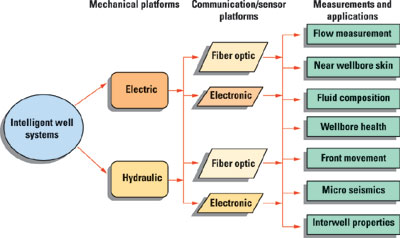 |
Fig. 1. Building on the platforms. Major components and applications of intelligent well systems.
|
|
VALUE BEYOND INTERVENTION
To date, the primary justification for using IW systems has been its ability to mitigate the clearly-defined costs of intervention. IW systems are now proven to allow the operator to change flow characteristics without need for well intervention, and potentially add several millions of dollars to well net present value (NPV). Fig. 2 shows the improved return of a three-zone well under managed inflow control, vs. intervention.
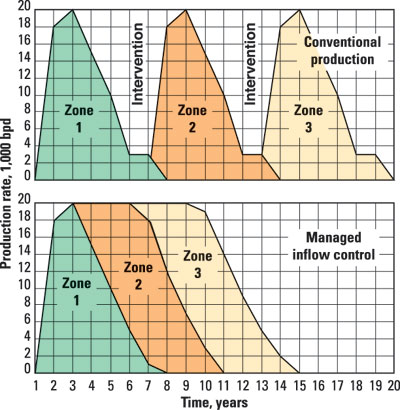 |
Fig. 2. Improved net present value of a three-zone well operated under conventional intervention methods and with managed inflow control.
|
|
However, economic justification for IW systems on the basis of intervention alone is limited. Specific cases support the axiom that, in fact, reducing or eliminating intervention accounts for less than 20% of the relative value of IW systems. It has become clear that the relative value impact of using IW technologies goes far beyond the cost in intervention. The real value lies with accelerated cash flow and increased ultimate recovery, Fig. 3.
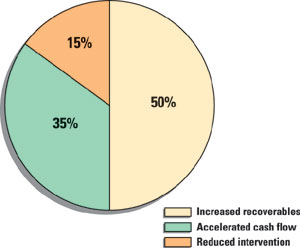 |
Fig. 3. Relative business value of IW systems.
|
|
For areas of the world that support commingled production, the ability to manage pressures between and among zones allows the operator to see faster payback on the asset, and keep the pipeline full. Additionally, the abilities to access previously isolated and abandoned zones for further depletion and to sweep the asset more efficiently – based on smarter management decisions enabled by applying knowledge realized from permanent monitoring – translate to an increase in recoverable reserves of anywhere from 2% to 15%.
CASE HISTORY CATEGORIES
Having employed IW systems since 1996, it is now possible to segment case studies into three distinct groups, as follows.
- Successful installation. With a direct impact on the drilling AFE, successful installation and commissioning of the completion balances the fine line between taking the right amount of time to make and test connections (and splices) and minimizing the amount of time getting the equipment in the hole, $/hr.
- Near-term value. Most IW systems are paying out in less than six months. This quick payback adds value beyond the cost of intervention, as production and reservoir personnel now apply the system to manage the asset. IW systems now deliver real-time buildup and drawdown profiles on demand. Injection programs can be evaluated quickly to determine whether they deliver modeled rates. In many cases, reservoir structures, specifically sealing faults, have been confirmed by IWS data parameters. The ability to isolate specific zones within an asset, pressure up the well and establish whether there is any communication to surrounding zones has tremendous benefit.
- Long-term value. With many systems having exceeded two years of flawless performance, we can now define the anticipated long-term value. It is here that we realize the true benefits of deferred or eliminated intervention. Additionally, comprehensive and detailed trending analysis supports the premise that better data translates to better asset management. This, in turn, leads to incremental recovery, with the ability to delay water or gas breakthrough, access previously isolated zones, and cycle zones through production and injection phases.
THE NEXT GENERATION
It is reasonable to expect that, as the technology continues on its strong acceptance path, there will be focus on driving down cost and applying next-generation products. Systems integration and application of reliability techniques are expected to augment the features of both low-end and high-end systems. The advent of fiber optics brings the opportunity to enhance both hydraulic and electrically based systems to the most efficient use of data acquisition and control. Opto-electric and opto-hydraulic systems will be available long before the market is ready to apply them.
In the area of permanent monitoring, we continue to see requests for what might become the norm in years to come. In-well parameters will be expanded to identify sand production, skin, fluid composition, corrosion, erosion and multiphase flow. Successful coupling of geophones now provides the ability to monitor micro-seismic events to accurately track fluid movement. Near- and far-well sensors are being developed to support cross-well electro-magnetics and acoustic imaging to refine tomography understanding even further.
Now integrate this technology with multilateral and expandable systems. Couple the technology with sand control operations and we can begin to see how IW systems technology complements recent advances in production and reservoir management, Fig. 4. The tools exist – the challenge is our ability to use them.
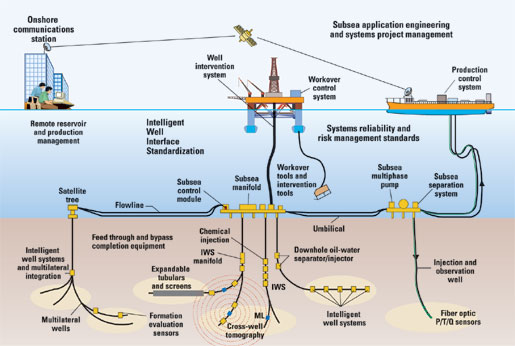 |
Fig. 4. Intelligent well systems: a macro view.
|
|
MANAGING DATA: THE FINAL HURDLE
To date, the focus on IW systems has correctly been targeted to minimizing risk and maximizing value of the downhole components. With tremendous IW performance in the last several years, focus now shifts to the infrastructure that truly facilitates its use.
Depending on acquisition rate, one well can easily generate a megabyte of raw data per day. Moving that data securely to the right user, at the right place and the right time, is a significant challenge. Similarly, legacy systems and working methods pose barriers to data transfer between various functional departments within E&P companies. Many of today’s methods for modeling IW data, once it has been transported, are infantile compared to real-time production management; and there are presently no textbooks to provide an efficient guide to using IW systems, Fig. 5.
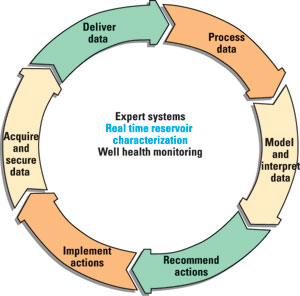 |
Fig. 5. The data management cycle.
|
|
However, significant success has already been realized by applying existing reservoir models with variations of nodal analysis and fast-track inversion. These techniques will no doubt evolve into real-time production and field management systems of the future.
The industry has come together to begin issuing Intelligent Well Interface Standards. Recommendations are being published to improve communication and interoperability, so equipment and data can be interchanged, and producers who share common reservoirs can maximize production.
The situation with regard to IW systems data evolution is comparable to that of seismic libraries. The ability to acquire seismic data was in place long before the ability to make sense of it. Ultimately, 3D seismic proved to be one of the most important and valuable technological breakthroughs in the upstream petroleum industry.
Intelligent well technology holds the promise for similar breakthroughs in real-time reservoir characterization and production management that will lead to significant increases in asset value. We are still a long way from neural networks and truly autonomous learning systems, but we are already at the point where the operative question regarding intelligent wells is moving from, Why should we use them? through Why wouldn’t we use them? to How should we use them? 
THE AUTHOR
|
 |
Jack Angel, director of marketing and engineering for Intelligent Well Systems at Baker Oil Tools, is responsible for developing and commercializing next-generation completion system solutions through the use of emerging technologies. He joined Baker Hughes in 1982 and has worked extensively throughout North America and the Asia-Pacific rim. Mr. Angel is a certified electronic engineering technologist and a member of SPE and API.
|
| |
|
|








